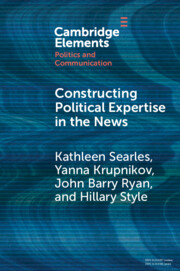55 results
Leaders but Not Authorities? Gender, Veterans, and Messages about National Security – ERRATUM
-
- Journal:
- American Political Science Review , First View
- Published online by Cambridge University Press:
- 20 May 2024, p. 1
-
- Article
-
- You have access
- HTML
- Export citation
Leaders but Not Authorities? Gender, Veterans, and Messages about National Security
-
- Journal:
- American Political Science Review , First View
- Published online by Cambridge University Press:
- 15 April 2024, pp. 1-16
-
- Article
- Export citation
Selecting Out of “Politics”: The Self-Fulfilling Role of Conflict Expectation
-
- Journal:
- American Political Science Review , First View
- Published online by Cambridge University Press:
- 16 February 2024, pp. 1-16
-
- Article
- Export citation

Constructing Political Expertise in the News
-
- Published online:
- 02 February 2023
- Print publication:
- 23 February 2023
-
- Element
- Export citation
Introduction to Freedom of Expression in an Age of Social Media, Misinformation, and Political Polarization
-
- Journal:
- PS: Political Science & Politics / Volume 56 / Issue 2 / April 2023
- Published online by Cambridge University Press:
- 05 January 2023, pp. 219-221
- Print publication:
- April 2023
-
- Article
- Export citation
Figures
-
- Book:
- The Other Divide
- Published online:
- 19 January 2022
- Print publication:
- 20 January 2022, pp viii-ix
-
- Chapter
- Export citation
8 - The Voice of Which People?
-
- Book:
- The Other Divide
- Published online:
- 19 January 2022
- Print publication:
- 20 January 2022, pp 203-232
-
- Chapter
- Export citation
2 - Subtleties of Partisan Division
-
- Book:
- The Other Divide
- Published online:
- 19 January 2022
- Print publication:
- 20 January 2022, pp 23-51
-
- Chapter
- Export citation
5 - Bubbles of Involvement
-
- Book:
- The Other Divide
- Published online:
- 19 January 2022
- Print publication:
- 20 January 2022, pp 111-134
-
- Chapter
- Export citation
1 - A House Divided against Itself?
-
- Book:
- The Other Divide
- Published online:
- 19 January 2022
- Print publication:
- 20 January 2022, pp 1-22
-
- Chapter
- Export citation
Appendix
-
- Book:
- The Other Divide
- Published online:
- 19 January 2022
- Print publication:
- 20 January 2022, pp 252-262
-
- Chapter
- Export citation
Contents
-
- Book:
- The Other Divide
- Published online:
- 19 January 2022
- Print publication:
- 20 January 2022, pp vii-vii
-
- Chapter
- Export citation
Index
-
- Book:
- The Other Divide
- Published online:
- 19 January 2022
- Print publication:
- 20 January 2022, pp 288-292
-
- Chapter
- Export citation
6 - Perceptions of the Most Sacred Duty
-
- Book:
- The Other Divide
- Published online:
- 19 January 2022
- Print publication:
- 20 January 2022, pp 135-166
-
- Chapter
- Export citation
Tables
-
- Book:
- The Other Divide
- Published online:
- 19 January 2022
- Print publication:
- 20 January 2022, pp x-x
-
- Chapter
- Export citation
9 - Middle Grove
-
- Book:
- The Other Divide
- Published online:
- 19 January 2022
- Print publication:
- 20 January 2022, pp 233-251
-
- Chapter
- Export citation
3 - Beyond Political Interest
-
- Book:
- The Other Divide
- Published online:
- 19 January 2022
- Print publication:
- 20 January 2022, pp 52-76
-
- Chapter
- Export citation
Dedication
-
- Book:
- The Other Divide
- Published online:
- 19 January 2022
- Print publication:
- 20 January 2022, pp v-vi
-
- Chapter
- Export citation
Preface and Acknowledgments
-
- Book:
- The Other Divide
- Published online:
- 19 January 2022
- Print publication:
- 20 January 2022, pp xi-xii
-
- Chapter
- Export citation
4 - The Deeply Involved Are Different
-
- Book:
- The Other Divide
- Published online:
- 19 January 2022
- Print publication:
- 20 January 2022, pp 77-110
-
- Chapter
- Export citation

